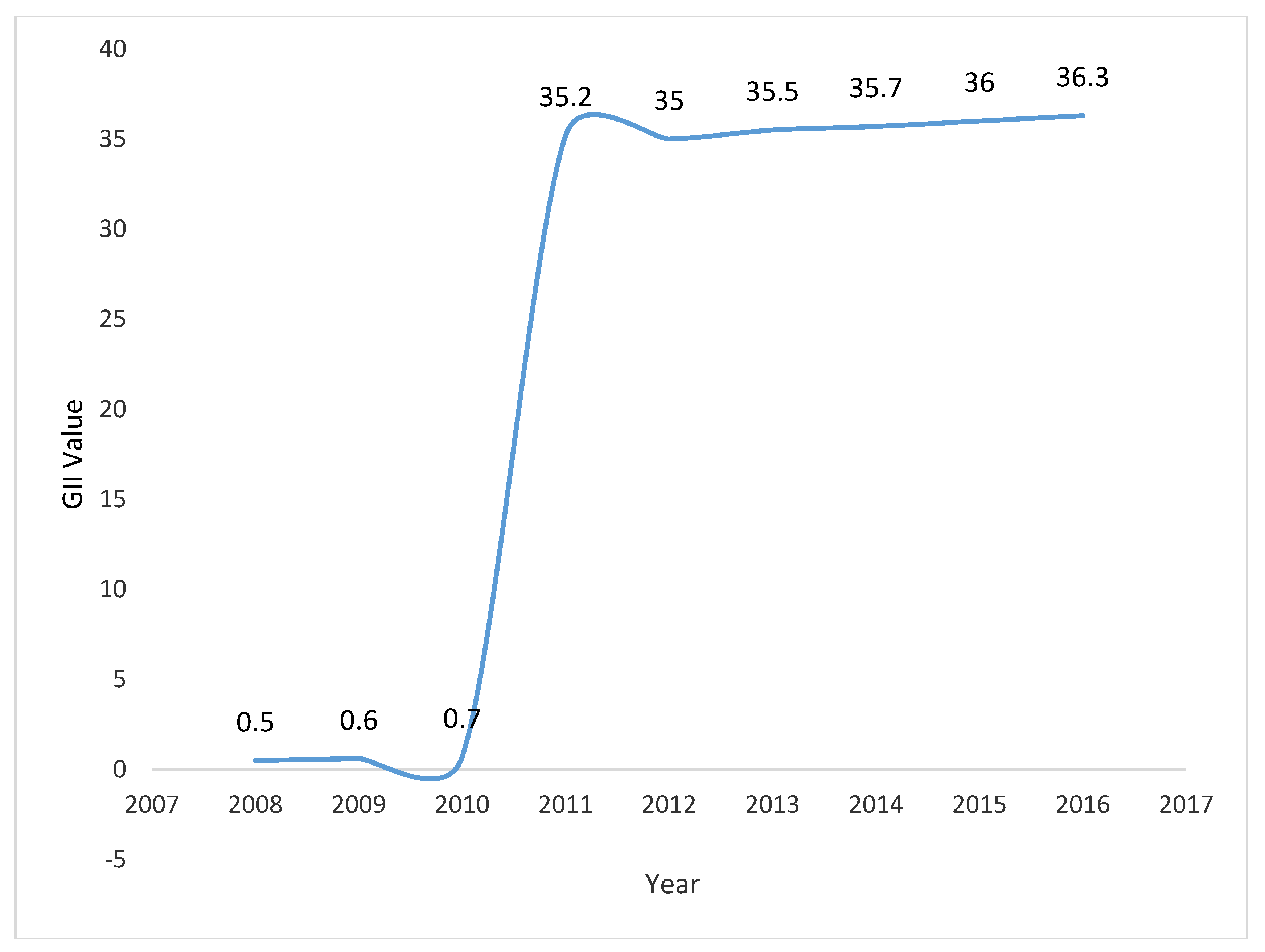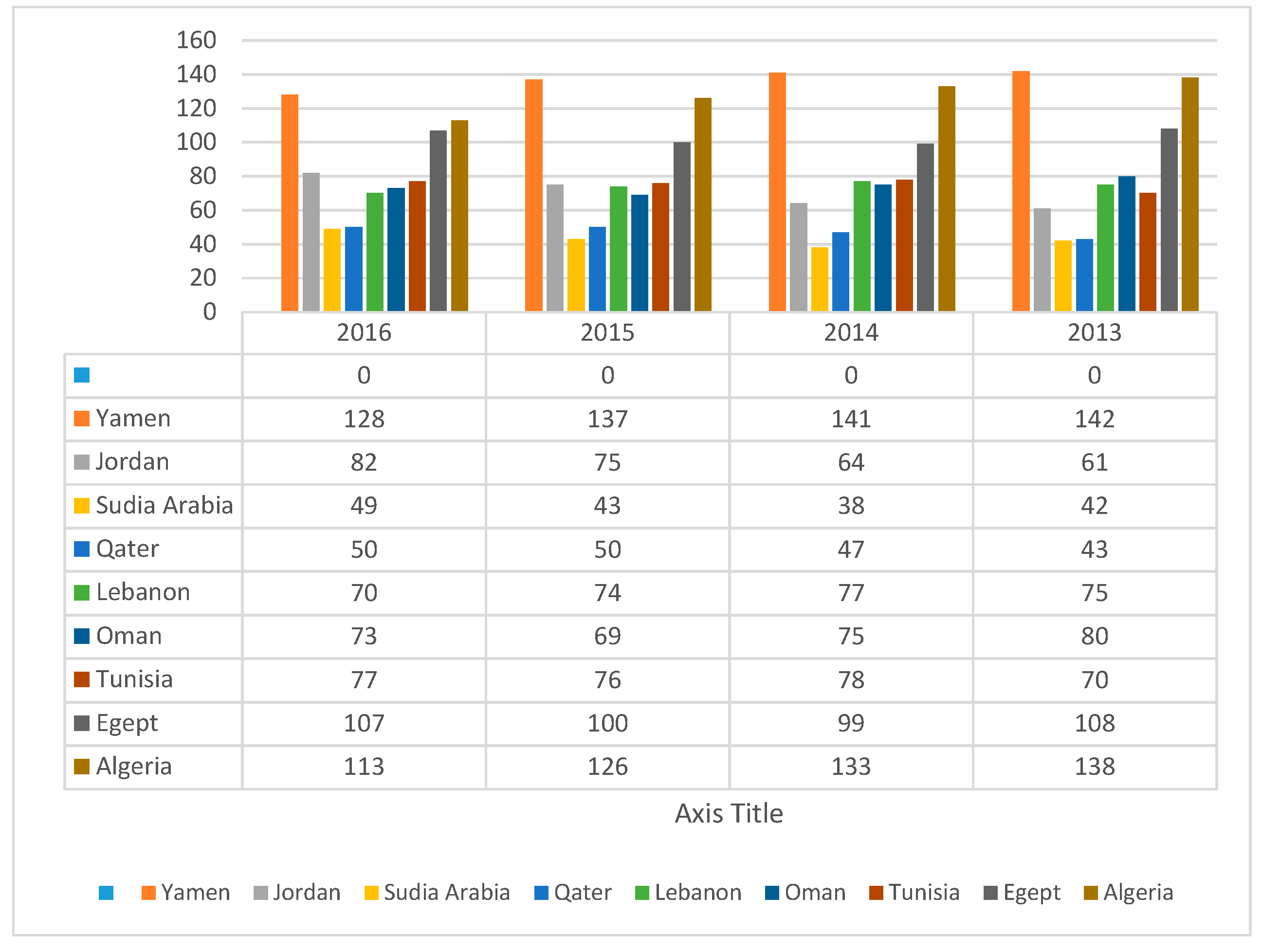Submitted:
26 January 2023
Posted:
27 January 2023
You are already at the latest version
Abstract
Keywords:
1. Introduction
2. Experimental
3. Results and Discussion
3.1. The Global Innovation Index
3.2. Listed Arabic Countries Global Innovation Index
4. Conclusion
References
- Alshamaileh, E., Al-Sulaibi, M., Al-Khawaldeh, A., Almatarneh, M., El-Sabawi, D. and Al-Rawajfeh, A. (2016), Current status of nanotechnology in Jordan, World Journal of Science, Technology and Sustainable Development, Vol. 13 No. 2, pp. 66-81. [CrossRef]
- Hourani, M. K. and Alkawaldeh A. (2016). Synergistic Effects of Bismuth Adatoms on Electrocatalytic Properties of Electrodeposited Nanostructured Platinum Electrodes. International Journal of Electrochemical Science, 3555–3566. [CrossRef]
- Altwaiq, A. Jawad, I Aljalab, T. Abu alhaj, O. Muwalla, M. and Alkhawaldeh, A. (2019) The Determination of Some Heavy Metals in Different Selected Diets, Eurasian Journal of Analytical Chemistry, 14 (4), 7-18.
- Ahmad Alkhawaldeh, Mariam Odettalah and Mohammed Hourani, (2019). Electrochemical Reduction of Carbon Dioxide by Application of a Square Wave Potential Regime at Polycrystalline Palladium Electrodes, Jordan Journal of Chemistry. 14(3), 105 – 112.
- Almatarneh, M. H., Elayan, I. A., Al-Sulaibi, M., Khawaldeh, A., Saber, S. O. W., Al-Qaralleh, M., and Altarawneh, M. (2019). Unimolecular Decomposition Reactions of Propylamine and Protonated Propylamine. ACS Omega, 4(2), 3306–3313. [CrossRef]
- Krishan, M. Alkhawaldeh, A. and Soliman, A. (2020). Development of Nitride-Sensors for Monitoring in Control Systems, Journal of Measurements in Engineering, 8 (3): 90-97. [CrossRef]
- Alkhawaldeh, A. K., and Alkhawaldeh, R. (2020). Highly Sensitive copper Heavy Metal Analysis on Nanoparticle Platinum and palladium electrode, International Journal of Engineering and Artificial Intelligence. 1(2): 33-39. [CrossRef]
- Alkhawaldeh, A. K., M.Krishan, M., Altwaiq, A., Dabaibeh, R. N. (2020). Preparation of Nanostructured/ Microplatinum Surfaces by Application of a Square Wave Potential Regime for Methanol Oxidation. Eurasian Journal of Analytical Chemistry, 15(1), emEJAC-00362.
- Alkhawaldeh, A. K., (2020). COVID-19: Simultaneous Surveillance Studies and Case Series, Jordan as a Case Study. International Journal of Multidisciplinary Sciences and Advanced Technology. Special Issue 1: Covid-19: 55-62.
- Alkhawaldeh, A. K., (2020). Analytics of Antimony in Natural Water of Nanoparticle Platinum Electrode by Application Square Wave Voltammetry. International Journal of Multidisciplinary Sciences and Advanced Technology, 1(4): 96-103.
- Alkhawaldeh, A. K., (2020). Electrical Conductivity of Natural Volcanic Tuff Mix by Cyclic Voltammetry Method, International Journal of Multidisciplinary Sciences and Advanced Technology, 1(5): 37-44.
- Alkhawaldeh, A. K., (2020). Platinum nanoparticle electrode modified iodine used cyclic voltammetry and chronoamperometric for determination of ascorbic acid. Analytical and Bioanalytical Electrochemistry, 12 (6): 780-792.
- Alkhawaldeh, A. K., (2020). Platinum Nanoparticle in Tantalum Electrode for the Electrochemical Analysis of Heavy Metal Ions. International Journal of Intelligent Computing and Technology, 4 (1): 25-35.
- Alkhawaldeh, A. K., (2020). Platinum Nanoparticles for the Electrochemical Study of Heavy Metal ions Formed by the Sputtering Deposition of the ion beam Electrode. International Journal of Engineering and Artificial Intelligence. 1(3): 1-8. [CrossRef]
- Almatarneh, M. Al Omari, R. Omeir, R. AlKhawaldeh, A. Afaneh, A. Sinnokrot, M. Akhras, A. Marashdeh, A. (2020) Computational Study of the Unimolecular and Bimolecular Decomposition Mechanisms of Propylamine, Sci Rep 10, 11698. [CrossRef]
- Altwaiq, A. , Khouri, S. , Abdel-Rahem, R. and Alkhawaldeh, A. (2020) Conductivity Method as a New Monitoring Technique for Corrosion and Corrosion Inhibition Processes of Zinc Metal. American Journal of Analytical Chemistry, 11, 349-361. [CrossRef]
- Alkhawaldeh, A. K., Alzawahreh, A., Alkhawaldeh, R., (2021). Electrochemical Sensors and Determination for Heavy Metal by Rotating Disk Platinum Electrode and Chronoamperometric Method. International Journal of Engineering and Artificial Intelligence, 2 (1): 17-26. [CrossRef]
- Alkhawaldeh, A. K., (2021). Electrochemical Analysis of Heavy metal by Cyclic Voltammetry Method. International Journal of Engineering and Artificial Intelligence, 2 (2): 27-33.
- Alkhawaldeh, A. K., (2021). Platinum nanoparticle electrode electrochemical lead (II) determination with square wave voltammetry modified with iodine. AIP Conference Proceedings, 2339 (1): 020221 (2021). [CrossRef]
- HudaAlhasan, Zhraa H. Obaid, Ahmad AlKhawaldeh, (2021). The extent of citizens’ knowledge of preservatives and their health effects, International Journal of Psychosocial Rehabilitation. 25 (2) (2021): 908-931.
- Alkhawaldeh, A. K., Abdel Hadi Al Jafari (2021). Electrochemical Sensors and Determination for silver ion by Cyclic Voltammetry at iodine-coated Platinum nanoparticles electrode. Annals of the Romanian Society for Cell Biology, 25 (6): 20280 – 20291.
- Abdullah Mohammed Al-Dhuraibi, Wadah Mohammed Al-Dhuraibi, Ahmad khalaf alkhawaldeh, Vladislav Soldatov, Mikhail Vladimirovich pokrovskiy (2021). Safety and Efficacy of Eltrombopag in Patients with Chronic Immune Thrombocytopenia: Meta-Analysis of Randomized Controlled Trials. Annals of the Romanian Society for Cell Biology, 25 (6): 20617 – 20634.
- Malek Khalaf Albzeirat, Kadhim H. Suffer, Nik Noriman Zulkepli, Ahmad Khalaf Alkhawaldeh. A Vision Future for Application Artificial Intelligent in Solar Energy. International Journal of Engineering and Artificial Intelligence, 2 (1). (2021): 60-70. [CrossRef]
- Ahmad Khalaf Alkhawaldeh. Technology patterns in Nanochemistry Based on GII Indicator. International Journal of Engineering and Artificial Intelligence, 2 (3). (2021): 28–32.
- Ahmad Khalaf Alkhawaldeh. Cyclic voltammogram analysis of the environmental aspects of the use of ferrocenyl carbinols. International Journal of Engineering and Artificial Intelligence, 2 (4). (2021): 7–12. [CrossRef]
- Abdullah Mohammed AL-Dhuraibi, Mikhail Vladimirovich Pokrovskiy, Ahmad khalaf alkhawaldeh, Wadah Mohammed AL-Dhuraibi (2021). Evaluation of Eltrombopag Efficacy in Patients with Hepatitis C-induced Thrombocytopenia: Systematic Reviews of Meta-Analysis. Natural Volatiles and Essential Oils, 8 (6): 5453 – 5471.
- Abdullah Mohammed AL-Dhuraibi, Ahmad khalaf alkhawaldeh, Iman Hassan Abdoon, Wadah Mohammed AL-Dhuraibi (2021). A comparative quantitative study of selected drugs commercialized in Yemen with HPLC. Natural Volatiles and Essential Oils, 8 (6): 5472 – 5483.
- Abdel Hadi Al Jafari, 29. Alkhawaldeh, A. K, (2022). The stability study of ginger exhaustive extraction using HPLC. Plant Cell Biotechnology and Molecular Biology, 23 (14): 55 – 60.
- Alkhawaldeh, A. K, Abdel Hadi Al Jafari, (2022). Cyclic voltammogram analysis of the 3,3´- (1,4-phenylene) perchlorates. International Journal of Engineering and Artificial Intelligence, 3 (2): 8–14.
- Ibtisam Jasim Sodani, Nadhum H. Safir, Ahmad Khalaf Alkawaldeh (2021). Potential pharmacological Therapeutics options for COVID-19: Review. International Journal of Natural and Human Sciences, 2 (2): 9-22.
- Ahmad khalaf alkawaldeh. (2021). Smart Care Business Uses the Internet of Things. J. New Medical Innovations and Research, 2 (3): 1–17. [CrossRef]
- Ahmad khalaf alkawaldeh, Malek Albzeirat. (2022). The Perception of Misuse of Antibiotics in Jordanian People. International Journal of Natural and Human Sciences, 3(1): 18–23.
- Malek Albzeirat, Osama Alkhawaldeh, Nadhum Safir, Nazih Bin-Abdun, Ahmad Khalaf Alkawaldeh, Kadhim Suffer. (2022). Development of a Hierarchical Model of Criteria for Construction of Nuclear Power Plants in the light of Nuclear Accidents from the World War to the Ukrainian-Russian War perception of misuse of antibiotics in Jordanian people. International Journal of Natural and Human Sciences, 3(1): 24–31.
- Ahmad khalaf alkawaldeh. Abdullah Mohammed AL-Dhuraibi, (2022). Nanotechnology of Status in Jordan. International Journal of Pharmaceutical and Nanoscience, 1 (1): 13-19.
- Ahmad khalaf alkawaldeh. Abdel Hadi Al Jafari, Abdullah Mohammed AL-Dhuraibi. (2022). Trends in contemporary culture in chemistry and pharmaceutical. International Journal of Pharmaceutical and Nanoscience, 1(1): 21-30.
- Ahmad khalaf alkawaldeh. Abdullah Mohammed AL-Dhuraibi. (2022). Cyclic voltammetry of heavy metal/amino acid in Jordanian water. International Journal of Pharmaceutical and Nanoscience, 1(1): 31-36.
- Mohammad Amer, Ahmad khalaf alkawaldeh. (2022). The ideal treatment for heart failer. International Journal of Pharmaceutical and Nanoscience, 1(1): 1-6.
- Ahmad khalaf alkawaldeh. Mohammed Hourani. (2020). Electrochemical reduction from carbon dioxide to urea through the application of a polycrystalline palladium electrode potential Square Wave Regime. J. Indian Chem. Soc., Vol. 97, No. 11a, pp. 2321-2328. [CrossRef]
- Ahmad khalaf alkawaldeh. (2022). Electrochemical study of Bismuth heavy metals using the cyclic voltammetry method in anti-protozoal. International Journal of Engineering and Artificial Intelligence, 3 (4): 1–7. [CrossRef]
- Ahmad khalaf alkawaldeh. (2022). Photocatalytic degradation of platinum nanostructure in tantalum electrode. Journal of Pharmaceutical Negative Results, Vol 13, Special Issue 9, 6264–6272.
- Ahmad khalaf alkawaldeh. Alhasan, Huda S. (2022). Enhanced electrochemical efficiency of lithium-ion battery using titanium and rhenium adatoms by the application of square wave potential regime. Egyptian Journal of Chemistry, https://doi.org/10.21608/EJCHEM.2022.117555.5538. [CrossRef]



Disclaimer/Publisher’s Note: The statements, opinions and data contained in all publications are solely those of the individual author(s) and contributor(s) and not of MDPI and/or the editor(s). MDPI and/or the editor(s) disclaim responsibility for any injury to people or property resulting from any ideas, methods, instructions or products referred to in the content. |
© 2023 by the authors. Licensee MDPI, Basel, Switzerland. This article is an open access article distributed under the terms and conditions of the Creative Commons Attribution (CC BY) license (http://creativecommons.org/licenses/by/4.0/).



